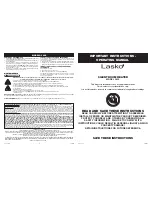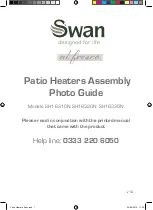
6
SAFETY INFORMATION
Please read and understand this entire manual before attempting to assemble, operate or install the
product.
·
CALIFORNIA PROPOSITION 65 WARNING: Chemicals known to the state of California to cause
cancer, birth defects or other reproductive harm are created by combustion of propane.
·
The installation must conform with local codes or, in the absence of local codes, with the National
Fuel Gas Code, ANSI Z223.1 /NFPA 54, Natural Gas and Propane Installation Code, CSA
B149.1, or Propane Storage and Handling Code, B149.2.
DANGER
·
Young children should be carefully supervised when they are in the area of the item.
·
Keep the ventilation opening(s) of the cylinder enclosure free and clear from debris. Use this
appliance in a well-ventilated space only. Do not use it in a building, garage or any other enclosed
area.
·
Use this appliance in outdoor areas described below:
(a) With walls on all sides, but at least one permanent opening at ground level and no overhead
cover.
(b) Within a partial enclosure that includes overhead cover and no more than two walls. These
walls may be parallel, or at right angles to each other.
(c) Within a partial enclosure that includes overhead cover and no more than two walls. The
following shall apply:
(i) One wall that is equivalent to at least 25% of the total wall area is completely open.
(ii) 30% or more in total of the remaining wall area is open and unrestricted.
·
Store the cylinder outdoors in a well-ventilated area (not in a building, garage, or other enclosed
area) out of the reach of children.
·
Do not store a spare LP-gas cylinder under or near this appliance.
·
Never fill the cylinder beyond 80 percent full.
WARNING
·
Inspect the visible portion of the hose before each use of the appliance
·
Perform a leak test with a soapy solution:
(a) To check gas connections.
(b) After connecting a new cylinder.
(c) Upon re-assembly after disassembly.
Please refer to the leak test procedure indicated in this instruction manual on page 15.
·
Replace the hose assembly prior to the appliance being put into operation if there is evidence of
excessive abrasion or wear, or if the hose is damaged. The pressure regulator and hose
assembly supplied with the appliance must be used. The replacement hose assembly/regulator
shall be that specified by the manufacturer.
·
Place the propane hose with regulator assembly out of pathways where people may trip over it or
in areas where the hose will not be subjected to accidental damage.






































